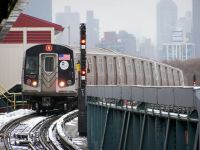The MTA recently unveiled a potential plan which would replace its fleet with single-car trains to some riders dismay. (Photo by: Julian Wong/The Ram)
Last month, the MTA proposed new subway cars for the systems a part of a 142-page report outlining a “21st Century Transit System.” The MTA would replace its existing fleet of nine-to-eleven single-car trains with one long articulated train that would resemble the city’s accordion-style buses.
Although this proposal is simply an idea, the MTA is seriously considering adopting these new trains.
One reason is that they have been successful in major cities like Toronto, Berlin, Paris and Hong Kong, mostly for reducing crowded trains. According to Brad Ross, a Toronto Transit Commission spokesman, capacity in Toronto’s subway increased by eight to ten percent in the two years these articulated trains have been in use there.
Maximizing carrying capacity has been a major challenge for the MTA as the city’s population grows. In response, the MTA added more trains during rush hours to accommodate riders. Subway cars , however, continue to be congested.
Perhaps these new trains are the answer to the sardine-packed morning and afternoon commutes, but there are a few flaws that need to be addressed.
Crime is one area of concern. What if, a maniac gets on the train with a weapon? This fiend will be able to hurt a lot of people on the train. If it happened today, people would have a chance to escape and get into a different car rather than have this person follow them through the entire train, exposing other people to the danger. A train without internal doors would also mean thieves and other criminals can roam the entire train and rob, assault or even kill more than one person. Chris Rhomberg, sociology professor and faculty member of the Urban Studies Program at Fordham, said this was “a matter of concern.”
On New Year’s Eve, drunk New Yorkers smell inside train cars. That car could be isolated and cleaned today, but would be impossible to do if it happened on an articulated train. The entire train would have to be put out of service instead of uncoupling the one car. Who knows how many trains would be left in the system on St. Patrick’s Day.
Of course a typical New York City subway ride would not be complete without the mariachi bands, performers, beggars and fruit snack peddlers that make their ways through each car every day. Articulated trains would be an open invitation for them to irritate unamused and unwelcoming passengers on the whole train for the duration of the ride. And what if a New York City rat got on the train?
Kelly Hung, GSB ’16, a commuter from Little Neck, Queens, saw and rode on the articulated trains when she was in Hong Kong. She said they are great, but cannot see them being the same in New York.
“You can use them in certain areas, not everywhere,” she said.
Another commuter, Kevin Noyola, GSB ’16, who commutes on the D train to 125th Street in Manhattan, said “the system is in need of new subway cars, but the articulated trains aren’t it.”
Rhomberg said that the current cars “should be good for another 40 years.”
Because of possible setbacks from the articulated trains, the MTA should not make this, a priority. The MTA has a lot on its hands right now, and thinking about what the agency needs in the next 20 years is too much of a commitment. The MTA, after all, does not have a great record when it comes to planning ahead.
Take East Side Access, the project that will bring the Long Island Railroad to Grand Central Terminal, for example. The project was slated to finish by the end of 2013, but will not be completed until August 2019. Another project set to be completed by this year was the Second Avenue Subway. The completion date is now either the end of 2016 or early 2017. If new cars were to come to the city’s subway, Rhomberg believes that these “larger projects will have more impact on the everyday experience of riders [than the new cars].”
For now, New Yorkers will be able to keep their iconic subway cars, and the habits that make riding the New York City subway a one of a kind experience.
Andrew Santis, GSB ’16, is an undeclared major from Flushing, N.Y.





